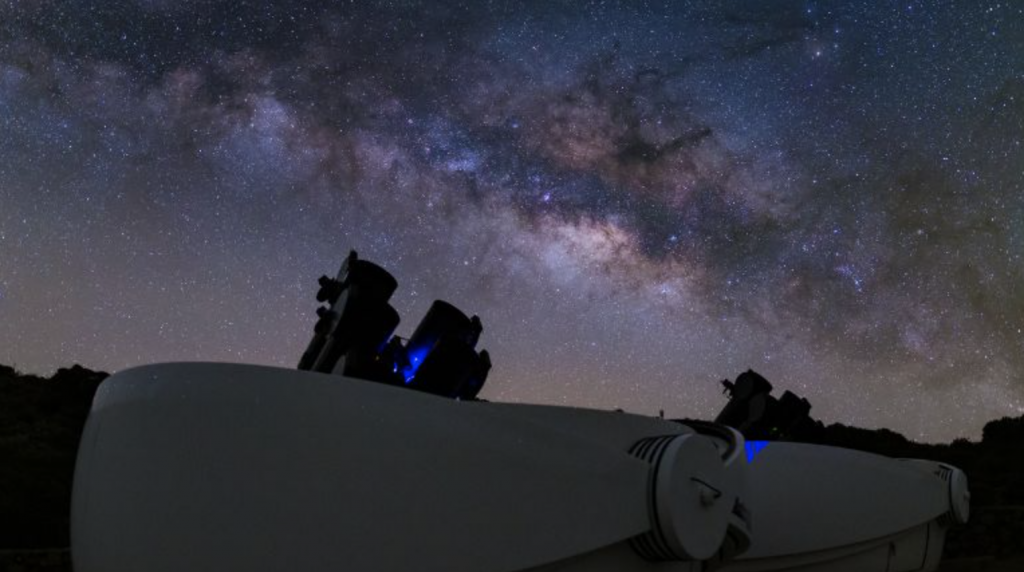Leicester space scientists will contribute to a huge new telescope, made up of identical arrays on opposite sides of the planet, to track down sources of gravitational waves.
The Gravitational-wave Optical Transient Observer (GOTO) will be deployed across two antipodal locations to fully cover the sky, and will scour our galaxy – and beyond – for optical clues about the violent cosmic events that create ripples in the fabric of space itself.

GOTO is led by the University of Warwick in collaboration with international partners including astrophysicists at the University of Leicester. Co-investigators include scientists from Australia, Thailand, Finland, Spain and other institutions in the UK.
The major project has now received £3.2 million of funding from the Science and Technology Facilities Council (STFC) to deploy the full-scale facility.
Paul O’Brien is Professor of Astrophysics and Space Science and Head of the Astrophysics Group at the University of Leicester and has been involved in developing the GOTO project since 2012. Professor O’Brien said: “GOTO can observe very large areas of the sky quickly, finding the sources of gravitational waves. We can then also use other powerful facilities, such as the recently launched JWST, in which Leicester is a partner. The STFC funding will allow us to operate GOTO and process the vast amount of data. It’s exciting to be involved in such a cutting-edge project and I look forward to seeing the Universe change before our eyes.”
Long hypothesised as a by-product of the collision and merger of cosmic behemoths such as neutron stars and black holes, gravitational waves were finally detected directly by the Advanced LIGO (Laser Interferometry Gravitational-wave Observatory) in 2015.
Since 2015, there have been many subsequent detections but, since observatories like LIGO can only measure the effects of the gravitational wave as it passes through our local patch of space time, it can be difficult to track down the source’s point of origin.
It would be like knowing that a truck has passed by feeling the rumble in a road’s surface and trying to work out where it came from based on that alone.

GOTO is designed to fill this observational gap by searching for optical signals in the electromagnetic spectrum that might indicate the source of the gravitational waves – quickly locating the source and using that information to direct a fleet of telescopes, satellites and instruments at it.
As most gravitational wave signals involve the merger of massive objects, these ‘visual’ cues are extremely fleeting and must be located as quickly as possible, which is where GOTO comes in.
GOTO will act as a sort of intermediary between the likes of LIGO, which detect the presence of a gravitational wave event, and more targetable multi-wavelength observatories that can study the event’s optical source.
Professor Danny Steeghs of the University of Warwick, GOTO’s Principle Investigator, said: “There are fleets of telescopes all over the world available to look towards the skies when gravitational waves are detected, in order to find out more about the source. But as the gravitational wave detectors are not able to pinpoint where the ripples come from, these telescopes do not know where to look.
“If the gravitational wave observatories are the ears, picking up the sounds of the events, and the telescopes are the eyes, ready to view the event in all the wavelengths, then GOTO is the bit in the middle, telling the eyes where to look.”
Following the successful testing of a prototype system in La Palma, on Spain’s Canary Islands, the project team is now preparing a site at Australia’s Siding Spring Observatory which will contain the same two-mount, 16-telescope system.
Dr Rhaana Starling, Associate Professor of Transient Astrophysics at the University of Leicester and co-investigator for the GOTO project, added: “Gravitational waves are produced by some of the most energetic events in the Universe. Places where we can test physics to its extremes and learn about how black holes and neutron stars accrete matter from around them and power fast jets and outflows streaming back out. GOTO will pinpoint these previously unseen systems, opening the door for important studies of physics that we cannot simulate on Earth.”
Both GOTO sites are expected to be operational later this year, ready for the next observing run of the LIGO/Virgo gravitational wave detectors in 2023.

 Subscribe to Physics & Astronomy's posts
Subscribe to Physics & Astronomy's posts
Recent Comments